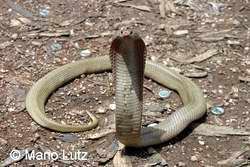
Those poor snakes. After the "revenge of the trees" caused by illegal loggers primarily, and typhoons Winnie and Yoyong, now comes the "revenge of the snakes."
See what happens when we do not take care of our environment. They "retaliate" in ways we do not expect and usher forth aftermaths that bring nothing but misery, anger, and remorse.
Displaced Cobras Threaten Quezon Relief Work By Anthony Vargas, Reporter
Deadly snakes, forced out of their nests by floodwaters, have become a serious threat in the typhoon-ravaged areas in Quezon.
Several persons have been bitten by snakes, particularly the highly venomous Philippine Cobra (Naja Naja philippinensis), Social Welfare Secretary Corazon Soliman said at a briefing at the National Disaster Coordinating Council office in Camp Aguinaldo Sunday.
"I don't have a figure yet of how many fell victims [to snakebites], but there are already several persons that were brought here in Manila for medical treatment," she said.
Soliman, who is a member of the NDCC, said the San Lazaro Hospital has dispatched a medical team with anti-venom serum to the stricken areas.
She said the Philippine Cobra, considered one of the world's dangerous snakes, might have been flushed out of the forests by heavy rains last week.
[The Manila Times]
The snakes are loose! And they are out to bite anyone in their paths.
Here's something about cobras:
I strongly doubt if victims of the Philippine Cobra can still count its scales during an encounter. The first reaction, of course, is always to run. Though that may not be a very good idea as this snake is very swift and as mentioned above, can spit its venom in a 3-meter range, I think standing still is also a very difficult option.
- Most cobras are large snakes, 1.2-2.5 meters in length. The king cobra, which may reach 5.2 m, is the largest venomous snake in the world. Cobras live throughout most of Africa and southern Asia. Their habitats vary. Some species adapt readily to life in cultivated areas and around villages.
- Adult Philippine cobras are uniformly light or medium brown, while juveniles are dark brown, with lighter variegations, sometimes a dark band behind the throat.
- They usually have 23-27 (usually 25) scale rows around neck, 21 (rarely 23) just ahead of mid-body; 182-193 ventrals, 36-49 subcaudals, basal pairs sometimes undivided.
- When encountered, cobras usually try to escape but occasionally defend themselves boldly and may appear aggressive. Most of these snakes elevate the head and spread the neck as a threat gesture.
- Most snakebites are inflicted on body extremities.
- By far, rural agricultural workers and other people in Asia and Africa receive most bites while working outdoors without protective footwear.
- Not all snakebites result in envenomation. In the case of cobras, the percentage of blank bites may be quite high, 45 percent in one series of 47 cases from Malaysia. In another series, 1 of 3 snake charmers bitten by large king cobras showed no signs of envenomation.
- Cobra envenomation is an extremely variable process. The envenomations of some species cause profound neurological abnormalities like, cranial nerve dysfunction, abnormal mental status, muscle weakness, paralysis, and respiratory arrest). With other snakes, local tissue damage is of primary concern.
- In addition to biting, some cobra species have a unique defense: they eject jets of venom toward an enemy, usually at the eyes. The effective discharge range of a large snake is at least 3 meters.
[eMedicine and W. WÜster Asiatic Cobra Systematics Page]
In the September 1988 issue of the American Journal of Tropical Medicine & Hygiene, a study by Watt and colleagues described what goes on inside the body of a bitten victim of the Philippine Cobra:
In brief, being bitten by a Philippine cobra can produce neurotoxicity and respiratory paralysis in as little time as 30 MINUTES from the time of the bite.We studied 39 patients envenomed by the Philippine cobra (Naja naja philippinensis). Neurotoxicity occurred in 38 cases and was the predominant clinical feature.
Respiratory paralysis developed in 19 patients, and was often rapid in onset --- in 3 cases, apnea (loss of respiratory function) occurred within 30 minutes of the bite. There were 2 deaths, both in patients who were moribund upon arrival at the hospital. Three patients developed necrosis, and 14 individuals with systemic symptoms had no local swelling. Both cardiotoxicity and reliable nonspecific signs of envenoming were absent. Bites by the Philippine cobra produce a distinctive clinical picture characterized by severe neurotoxicity of rapid onset and minimal local tissue damage.
[Am J Trop Med Hyg. 1988 Sep;39(3):306-11]
For those going on voluntary relief work in Quezon province, I strongly advise you read these additional tips.
God bless us all.
0 reactions:
Post a Comment